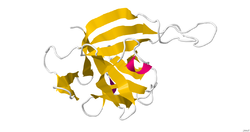
Interleukin 33

2KLL, 4KC39086577125ENSG00000137033ENSMUSG00000024810O95760Q8BVZ5NM_001314047NM_001314048NM_033439NM_001353802NM_001164724NM_133775NM_001360725NP_001300976NP_001300977NP_254274NP_001340731NP_001158196NP_598536NP_001347654Interleukin 33 (IL-33) is a protein that in humans is encoded by the IL33 gene. Interleukin 33 (IL-33) is a protein that in humans is encoded by the IL33 gene. Interleukin 33 is a member of the IL-1 family that potently drives production of T helper-2 (Th2)-associated cytokines (e.g., IL-4). IL33 is a ligand for ST2 (IL1RL1), an IL-1 family receptor that is highly expressed on Th2 cells, mast cells and group 2 innate lymphocytes. IL-33 is expressed by a wide variety of cell types, including fibroblasts, mast cells, dendritic cells, macrophages, osteoblasts, endothelial cells, and epithelial cells. IL-33 is a member of the IL-1 superfamily of cytokines, a determination based in part on the molecules β-trefoil structure, a conserved structure type described in other IL-1 cytokines, including IL-1α, IL-1β, IL-1Ra and IL-18. In this structure, the 12 β-strands of the β-trefoil are arranged in three pseudorepeats of four β-strand units, of which the first and last β-strands are antiparallel staves in a six-stranded β-barrel, while the second and third β-strands of each repeat form a β-hairpin sitting atop the β-barrel. IL-33 is a ligand that binds to a high-affinity receptor family member ST2. The complex of these two molecules with IL-1RAcP indicates a ternary complex formation. The binding area appears to be a mix of polar and non-polar regions that create a specific binding between ligand and receptor. The interface between the molecules has been shown to be extensive. Structural data on the IL-33 molecule was determined by solution NMR and small angle X-ray scattering. Interleukin 33 (IL-33) is a cytokine belonging to the IL-1 superfamily. IL-33 induces helper T cells, mast cells, eosinophils and basophils to produce type 2 cytokines. This cytokine was previously named NF-HEV 'nuclear factor (NF) in high endothelial venules' (HEVs) since it was originally identified in these specialized cells. IL-33 acts intracellularly as a nuclear factor and extracellularly as a cytokine. IL-33 is constitutively located in the nucleus of structural cells of humans and mice and has a helix-turn-helix domain presumably allowing it to bind to DNA. There is a paucity of research into the nuclear role of IL-33 but amino acids 40-58 in human IL-33 are sufficient for nuclear localisation and histone binding. IL-33 also interacts with the histone methyltransferase SUV39H1 and murine appears to IL-33 interact to NF-κB. As a cytokine, IL-33 interacts with the receptors ST2 (also known as IL1RL1) and IL-1 Receptor Accessory Protein (IL1RAP), activating intracellular molecules in the NF-κB and MAP kinase signaling pathways that drive production of type 2 cytokines (e.g. IL-5 and IL-13) from polarized Th2 cells. The induction of type 2 cytokines by IL-33 in vivo is believed to induce the severe pathological changes observed in mucosal organs following administration of IL-33. IL-33 is also effective in reversing Alzheimer-like symptoms in APP/PS1 mice, by reversing the buildup and preventing the new formation of amyloid plaques. Extracellularly, IL-33 is rapidly oxidised. The oxidation process results in the formation of two disulphide bridges and a change in the conformation of the molecule, which prevents it from binding to its receptor, ST2. This is believed to limit the range and duration of the action of IL-33. IL-33 has been associated with several disease states through Genome Wide Association Studies: asthma, allergy, endometriosis, and hay fever. In particular, a single-nucleotide polymorphism rs928413 (A/G), is located in the 5′ upstream region of IL33 gene, and its minor “G” allele was identified as a susceptible variant for early childhood asthma and atopic asthma development. The rs928413(G) allele creates a binding site for the cAMP responsive element-binding protein 1 transcription factor that may explain the negative effect of the rs928413 minor “G” allele on asthma development. “T” allele of the polymorphism rs4742170 located in the second intron of IL33 gene was linked to specific wheezing phenotype (intermediate-onset wheeze). Risk “T” rs4742170 allele disrupts binding of GR transcription factor to IL33 putative enhancer that may explain the negative effect of the rs4742170 (T) risk allele on the development of wheezing phenotype that strongly correlates with allergic sensitization in childhood.
